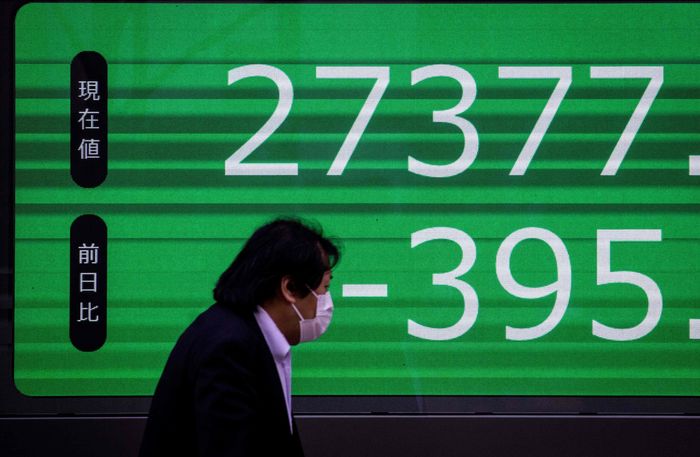Business & Economy
Stock market news live updates: Stocks close higher as investors await…

Wall Street’s key benchmarks charged forward Tuesday as investors continued to weigh company earnings against the impending monetary tightening that has eroded enthusiasm for stocks in recent weeks.
The Dow Jones Industrial Average closed up 372.24 points, or 1.06%, while the S&P 500 edged 0.84 higher to end the session in positive territory. The Nasdaq Composite rose 178.79, or 1.28%, buoyed by gains in Big Tech, even as rising bond yields pressured the sector. The 10-year U.S. Treasury note hit 1.95%.
Despite recent volatility, DataTrek Research’s Nicholas Colas and Jessica Rabe point out that the S&P 500 is generating 12.4 percent net profit margins at present, based on data from the 54% of companies that have reported fourth quarter results so far. The figure beats the pre-pandemic peak of 12.0 percent in the third quarter of 2018, even if it falls below Q1-Q3 2021’s range of 12.8-13.1%.
“What we’re seeing from here on is a more sustainable pace of growth,” Principal Global Advisors chief strategist Seema Shah told Yahoo Finance Live. “You’ll still see consumers, which are very resilient backed up by excess savings, supply chain normalizations for a boost of inventories and production, and you have corporate balance sheets which are still very, very strong.”
Mixed fourth quarter results from U.S. tech giants have weighed on investors in recent weeks as they already grapple with a Fed readying to tighten monetary conditions and raise interest rates as soon as next month.
“We, as investors paying attention to what’s going on in these companies, just have to recognize that a lot can change,” JPMorgan Asset Management global market strategist Jack Manley told Yahoo Finance Live. “It’s going to be a difficult time for earnings.”
Stocks had a turbulent last week after a disappointing outlook from Meta Platforms (FB) sent the company cratering in the biggest single-day wipeout in market history, dragging other tech peers down in a broader sell-off before posted a sharp comeback following an earnings beat by Amazon’s (AMZN). Another trove of results lies in store for investors this week from companies including Disney (DIS), Uber (UBER) and Coca-Cola (KO).
“The first few weeks of this year were driven much more by macro concerns — higher interest rates, pricing the Fed, inflation,” Stuart Kaiser, UBS head of equity derivatives research, told Yahoo Finance Live. “Since then, we’ve had a window of opportunity where earnings took over.”
Despite a steep sell-off in Meta, other tech companies reported strong earnings that allowed the market to recover, Kaiser added.
“Now that that’s over – about 70% of S&P companies and 80% of tech companies reported earnings – we do think the focus shifts back to the macro side of the ledger this week,” he said, adding that the European Central Bank and Bank of England are tightening monetary policy along with the Fed and a series of high inflation prints are expected in coming months. “When we put that all together, we don’t think the bumpy ride is over.”
The Consumer Price Index (CPI) will be closely watched on Thursday and is likely to show another multi-decade high print on inflation, a reading that could prompt the Fed to assert the more hawkish stance it has taken on. Economists expect a headline CPI print of 7.3% in January over last year, which would mark the fastest rise since 1982, according to consensus estimates compiled by Bloomberg.
Bank of America said in a note out Monday that more downside in equities is likely — at least according to history.
The S&P 500 year-to-date-correction from early to late January was 9.8% on a daily closing price basis. During the midterm year of a U.S. presidential cycle, corrections on the S&P 500 averaged 20%, BofA technical research strategist Stephen Suttmeier pointed out. In 17 of 21 midterm years, the S&P 500 had corrections greater than 9.8%, 15 years saw corrections of 15% or more, and nine out of 10 experienced corrections of at least 20%.
The index struggles just after a first Fed rate hike but tends to do better for the 5-, 6- and 12-month periods after initial increase, according to Suttmeier. Furthermore, the best part of the presidential cycle follows from the midterm year low through the third year of the term. Bank of America indicated that rallies off the low into year-end can be strong and have an average return of 17.6%.
“U.S. equities tend to struggle just after the first rate hike of a Fed tightening cycle, which could come as early as the March FOMC meeting, but the data suggest buying a dip,” Suttmeier wrote.
